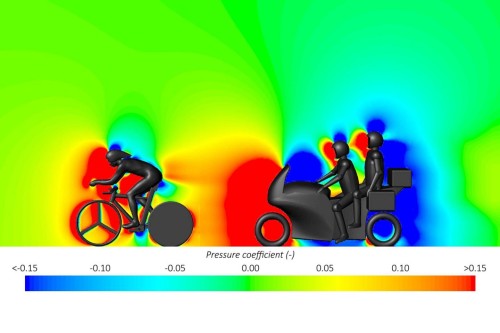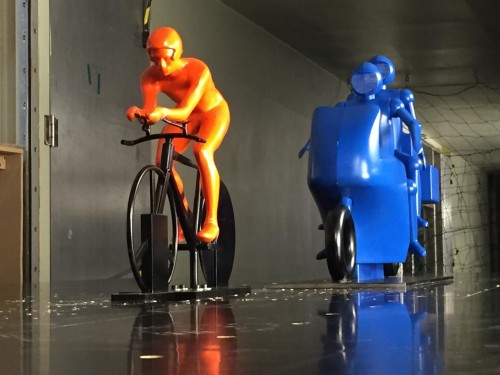
Easy does it: this computer simulation of a motorbike following a cyclist shows a drop in pressure (red area) that cuts the aerodynamic drag on the cyclist by almost 9%. (Courtesy: Eindhoven University of Technology)
By Matin Durrani
Some of the world’s top cyclists are gathering today in the Dutch city of Apeldoorn to take part in the opening stage of the 2016 Giro d’Italia – the 99th running of a race that is one of the three big European professional cycling stage races, along with the Tour de France and the Vuelta a España.
Today’s stage is a short (10 km) time trial and will be followed by two, longer stages in the Netherlands before the action moves to Italy, where the race is due to end on 28 May in Turin. Now, even if you have no interest in cycling – and mine stretches no further than tootling back and forth to work each day – one thing that looks truly scary about professional cycle races such as the Giro d’Italia is the phalanx of motorbikes following in the wake of the cyclists.
These motorbikes can carry everyone from TV camera operators and press photographers to doctors, traffic managers and support staff, all keen to keep as close as possible to the action. Now, however, researchers in the Netherlands and Belgium have discovered that having a motorbike right behind a cyclist could give the latter an advantage. Led by Bert Blocken, a physicist in the Department of the Built Environment at Eindhoven University of Technology, the study reveals that a motorbike at a distance of 25 cm behind a cyclist can cut aerodynamic drag on the person on the bicycle by almost 9%. That amounts to a reduction of almost 3 s for every kilometre travelled.
Blocken’s study, which involved computer simulations and wind-tunnel tests, has been accepted for publication as a paper in the Journal of Wind Engineering & Industrial Aerodynamics. Based on work with Blocken’s Eindhoven colleague Yasin Toparlar and Thomas Andrianne of the University of Liège in Belgium, the study considers a cyclist 183 cm tall, weighing 72 kg and wearing “an aerodynamic helmet and a standard tight-fitting racing suit with long sleeves”. Both wheels are fixed and the rider is a time-trial position, although the models in the wind-tunnel test are about a quarter of their real size.

Hot pursuits: examining the effects of a motorbike on a cyclist in a wind tunnel at the University of Liège. (Courtesy: Eindhoven University of Technology)
Blocken found that for a 50 km ride, a motorbike just 50 cm behind the cyclist would cut the latter’s overall time by 108.7 s. If the motorbike is 1 m, 2.5 m, 5 m and 10 m behind, the potential time reduction falls to 64.2 s, 20.1 s, 5.6 s and 1.0 s, respectively.
Realizing that it’s unlikely for a cyclist to be pursued that closely for such a long distance, Blocken adds that if the motorbike follows 25 cm behind the cyclist for just 1 km, the aerodynamic benefits would give the cyclist a 2.98 s advantage. At separation distances of 0.5 m, 1 m, 2.5 m, 5 m and 10 m, the benefit drops to 2.17 s, 1.28 s, 0.40 s, 0.11 s and 0.02 s. “For the shortest distances [that] is still enough to be potentially decisive [in a race],” say the researchers.
Blocken is a keen cyclist who in his younger days used to cover more than 10,000 km on a bike each year, but his study’s no laughing matter. With motorbikes in hot pursuit of riders, accidents can and do occur. In March this year, for example, a cyclist died following a collision with a “commissaire” bike in the Gent–Wevelgem race in Belgium. In fact, Blocken told Physics World that it was this collision that made him “morally obligated” to publish his findings.
Although not criticizing cyclists, motorbikers or the authorities for any accidents that occur in cycling, Blocken is now calling on the UCI (International Cycling Union) – on the grounds of safety and to stop any riders being unfairly advantaged – to extend the minimum distance between a motorbike and cyclist from its current 10 m to perhaps 20 m or even 30 m. Blocken says he rates the chances of rule changes taking place as “very high”, but warns that it might take “five or six years” for regulations to be altered. So who knows, could motorbikes influence the outcome of today’s race in Apeldoorn?
For more on the physics of cycling, watch our video with sports physicist Steve Haake of Sheffield Hallam University in the UK.
A motorbike closely following the competing cyclist does help the person aerodynamically, but is also source of seriously harmful accidents.
Congratulations Asghar – that is the whole point of the blog post! Thanks for reiterating it.
Dr. Durrani, you would have known all of this on your “eye tips”, if you had the “Tour de GrandeBretagne” in the country like the “Tour de France”. Moreover, the aerodynamical advantage for the cyclist due to the presence of the motorbike on its back is exaggerated, because the motorbike is mostly on the cyclist’s side and not behind it and, of course, the dynamical crowding does lead to accidents without any advantage.